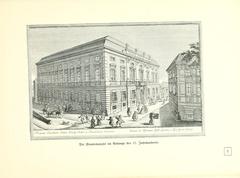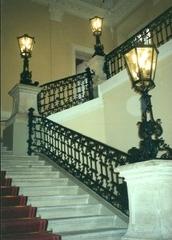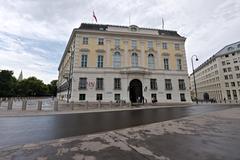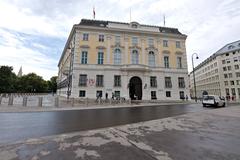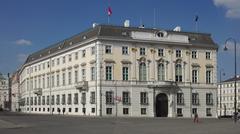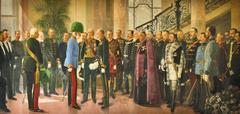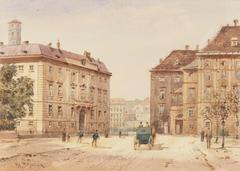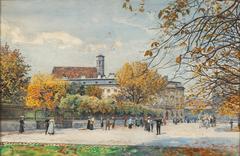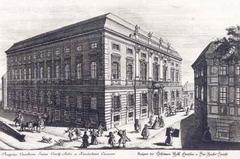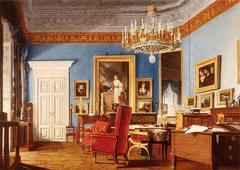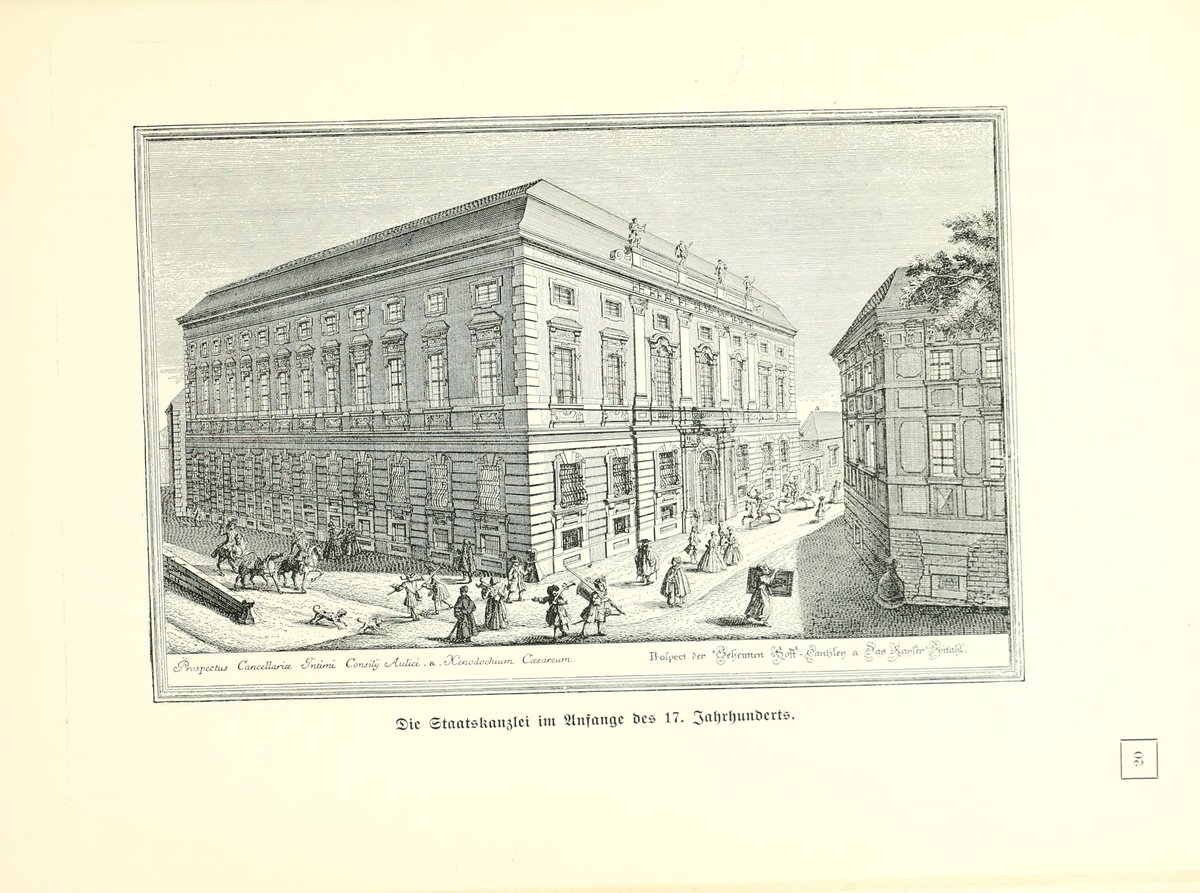
Austrian Chancellery: Visiting Hours, Tickets, and Historical Significance in Vienna
Date: 14/06/2025
Introduction
The Austrian Chancellery (Bundeskanzleramt), at the heart of Vienna’s Innere Stadt, is a landmark where Austria’s imperial past and modern democratic identity converge. This guide provides a comprehensive overview of the Chancellery’s history, architecture, political role, and essential visitor information—including hours, ticketing, accessibility, and nearby attractions. Whether you’re an architecture enthusiast, history buff, or cultural traveler, the Austrian Chancellery is a must-see for understanding Vienna’s political and historical landscape (Bundeskanzleramt.gv.at).
Table of Contents
- Introduction
- Historical Origins and Architectural Development
- Political Significance and Historical Figures
- The Haus-, Hof- und Staatsarchiv
- War Damage and Restoration
- Visiting the Chancellery: Hours, Tickets, and Tours
- Accessibility and Photography Guidelines
- Nearby Attractions and Travel Tips
- The Congress Hall and Modern Functions
- Integration with Vienna’s Urban Fabric
- Frequently Asked Questions (FAQ)
- Conclusion
- References
Historical Origins and Architectural Development
Founded under Emperor Charles VI, the Austrian Chancellery’s construction began in 1717, based on designs by the acclaimed Baroque architect Johann Lukas von Hildebrandt. Completed in 1721, the Chancellery was strategically placed next to the Hofburg Palace to centralize Habsburg diplomatic and administrative operations (Bundeskanzleramt.gv.at). Subsequent expansions in the 19th century—such as a dedicated archive building—reflect evolving governmental needs and architectural tastes (Burghauptmannschaft.at).
The Chancellery’s Baroque façade, tall windows, and grand entrance exemplify Vienna’s imperial architectural heritage. Interior highlights include state rooms adorned with period furnishings, gilded stucco, and portraits of historical statesmen (yourcityvisit.com).
Political Significance and Historical Figures
Throughout its history, the Chancellery has housed significant political figures, such as Prince Metternich during the Congress of Vienna (1814/15) and Prince Felix of Schwarzenberg. Following the monarchy’s end, the building became the central office for Austria’s Federal Chancellor, illustrating its unbroken role in the country’s governance (Burghauptmannschaft.at).
The Haus-, Hof- und Staatsarchiv
The Chancellery also hosts the Haus-, Hof- und Staatsarchiv, safeguarding vital documents including the oldest imperial certificate (816) and the Austrian State Treaty of 1955. This archive underscores the building’s dual function as a seat of government and a guardian of national memory (Burghauptmannschaft.at).
War Damage and Restoration
Severely damaged during World War II, the Chancellery underwent meticulous restoration post-1945, modernizing facilities while preserving historical integrity. Since 2004, it has also accommodated the Ministry of the Exterior, reaffirming its pivotal governmental status (Burghauptmannschaft.at).
Visiting the Chancellery: Hours, Tickets, and Tours
Opening Hours
The Austrian Chancellery is not open for daily public visits; access is limited to special events such as Vienna’s Open House Day and Austrian National Day (October 26), typically from 9 a.m. to 5 p.m. These occasions allow visitors to tour selected historic rooms and ceremonial halls.
Tickets and Tours
Admission on Open Door Days is free—no advance tickets are generally required, though early arrival is recommended due to high demand. Private or educational group tours outside these events must be pre-arranged via official channels. Special event tours often include expert commentary in German and English (Bundeskanzleramt.gv.at).
Guided Tours
Guided tours are not offered on a regular basis. During public events, guided commentary and interpretive materials enhance the visitor experience.
Security and Entry
Expect thorough security checks on public access days, including bag inspections and ID verification. Photography is permitted in designated public areas but may be restricted in sensitive zones.
Accessibility and Photography Guidelines
The Chancellery is wheelchair accessible, with ramps and elevators available. Some historic rooms may offer limited access to preserve their condition. Guide dogs are permitted. Visitors should follow all staff instructions regarding photography and conduct.
Nearby Attractions and Travel Tips
Ideally located on Ballhausplatz, the Chancellery is surrounded by Vienna’s top historical sites:
- Hofburg Palace: Former imperial residence, now home to museums and the National Library
- Heldenplatz: The historic “Heroes’ Square” central to national events
- Michaelerplatz and Josefsplatz: Baroque squares rich in architectural heritage
- St. Stephen’s Cathedral: Vienna’s Gothic masterpiece
- Albertina Museum and Vienna State Opera: Cultural highlights within walking distance
Public transport is convenient: Herrengasse (U3) and Stephansplatz (U1/U3) U-Bahn stations are nearby. Numerous tram and bus lines serve the area (Vienna-Trips.at, Insight Cities).
The Congress Hall and Modern Functions
The Congress Hall, renowned for the 1815 Congress of Vienna, remains a venue for political events, official statements, and weekly council meetings, continuing the Chancellery’s tradition as the heart of Austrian governance.
Integration with Vienna’s Urban Fabric
The Chancellery’s strategic centrality links it with the Hofburg Palace and the city’s power axis along the Ringstrasse, integrating it into Vienna’s civic and architectural identity (eurotravelsbydesign.com, architectureofcities.com).
Frequently Asked Questions (FAQ)
Q: When can I visit the Austrian Chancellery?
A: Only during special public events such as Open House Day and Austrian National Day. Check the official website for updates.
Q: Do I need tickets?
A: Admission is free on public open days; advance tickets are typically not required, but early arrival is advised.
Q: Are regular guided tours available?
A: No, only during special events or by prior arrangement for educational/diplomatic groups.
Q: Is the building accessible?
A: Yes, but access to some historic rooms may be limited.
Q: Can I take photos?
A: Photography is allowed in public areas; restrictions apply elsewhere.
Q: What are the best nearby sites?
A: Hofburg Palace, Heldenplatz, Michaelerplatz, St. Stephen’s Cathedral, Albertina Museum, and Vienna State Opera.
Visuals and Interactive Elements
For a richer experience, explore high-quality images of the Chancellery’s façade and interiors on official tourism sites. Interactive maps and virtual tours of the Hofburg complex are available online to enhance your visit.
View the Austrian Chancellery on Google Maps
Conclusion
The Austrian Chancellery is a living monument to Austria’s imperial grandeur and democratic present. While public access is limited, Open Door Days provide rare insights into the nation’s political heart. Surrounded by Vienna’s most celebrated historic sites, the Chancellery is a focal point for anyone eager to understand Austria’s past, present, and place within the European community.
For up-to-date details on visiting hours, ticketing, and special events, consult the official Austrian Chancellery website. Enhance your Vienna adventure by downloading the Audiala app for interactive maps, audio guides, and event alerts. Don’t miss our related articles on the Hofburg Palace and Vienna Historical Sites to Visit.
References
- Visiting the Austrian Chancellery in Vienna: History, Tours, and Visitor Information, 2025, Bundeskanzleramt.gv.at (Bundeskanzleramt.gv.at)
- Discover the Austrian Chancellery in Vienna: Architecture, History & Visitor Guide, 2025, YourCityVisit.com (yourcityvisit.com)
- Visiting the Austrian Federal Chancellery: Hours, Tours, and Historical Insights in Vienna, 2025, Bundeskanzleramt.gv.at (Bundeskanzleramt.gv.at)
- Integration with Vienna’s Urban Fabric, 2025, Vienna-Trips.at (Vienna-Trips.at)
- The Famous Buildings and Architecture of Vienna, 2025, EuroTravelsByDesign.com (eurotravelsbydesign.com)
- Vienna Travel Guide: What to Know for Your Visit, 2025, Insight Cities (Insight Cities)
